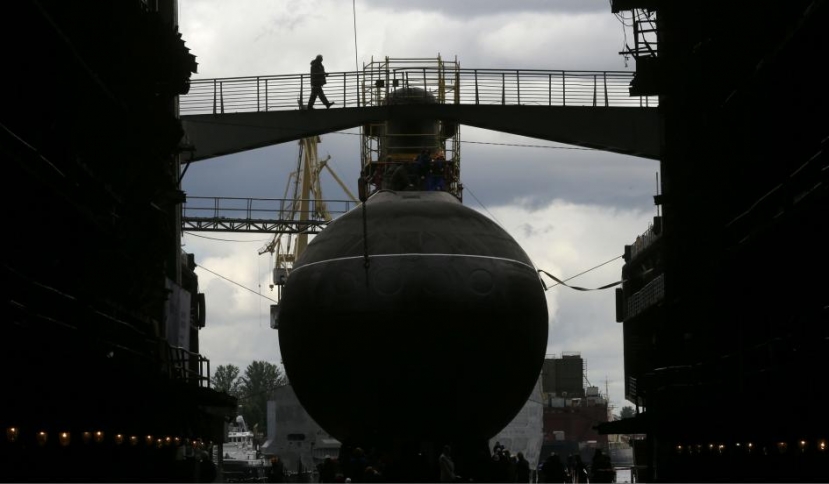The Secret Norwegian Submarine Base Being Rented by the Russians
23.03.2015 00:37
 The Secret Norwegian Submarine Base Being Rented by the Russians
The Secret Norwegian Submarine Base Being Rented by the Russians
Norway is ruing the day it sold off a key submarine base near the Russian border and now, with President Putin flexing his muscles in the region, there is growing alarm among Nato chiefs that the west has left itself woefully unprotected.
Only six years ago, Norwegian politicians decided that Russia no longer posed a significant threat and that it was time to sell its top secret base called Olavsvern, which was hewn into a mountain and equipped with the most sophisticated electronics available. It’s located near the small town of Ramfjord near Norway’s border with Russia.
“Our military and civilian readiness has been badly weakened,” says Anne-Margrete Bollmann, a former career military officer and now president of the Norwegian Defence Association. “Facilities have been closed, reserve capabilities have been reduced, readiness plans have been forgotten. Olavsvern is a prime example of a facility that has been lost, and in hindsight it’s clear that selling it was not a good decision.”
Bollman believes that the increasing strategic importance of Norway and thus Nato’s North requires a permanent military presence in the region.
She is not alone. “[The Ukraine crisis] demands of us that we be more watchful of the activities that are taking place in our core areas,” Norway’s defence minister Ine Eriksen Soreide said recently said in a newspaper interview. “We need a Nato that has a good understanding of its regional areas.”
On 16 March, Putin raised Russia’s Northern Fleet to full combat readiness in exercises in Russia’s Arctic North, a move clearly intended as a response to Norway’s recently-completed Joint Viking exercise in the High North, its largest military exercise in a generation.
Russian defence minister Sergei Shoygu said the order came from Putin himself, who has promised to spend more than 21 trillion rubles ($340bn) by the end of the decade to overhaul Russia’s fighting forces.
The sale of Olavsvern was long in the making. Eventually, the government put it up for sale on finn.no, a Norwegian equivalent of eBay. Even then, this “unique property” – as the sales pitch put it – with a total area of 948,900 square metres, failed to catch the 105 million kroner (€12.1m) price the government had hoped for. In the end, it was sold to a businessman named Gunnar Wilhelmsen for 38.1 million kroner (€4.4m).
Compounding military officials’ anxiety, Wilhelmsen now rents the base out to a fleet of Russian research vessels. Wilhelmsen didn’t respond to an interview request, but on his website, he extols Olavsvern’s virtues, advertising a 25,000 square-metre mountain plant featuring a 3,000 square-metre deep-water quay (and 124 bedrooms).
One of the recently arrived ships at Olavsvern is the Akademik Nemchinov, which belongs to Sevmorneftegeofizika, a Russian geophysics company that specialises in seismic measuring in deep and shallow waters. Seismic surveys are a bona fide area of international research, so seismic research vessels docking in another country is not unusual. But Sevmorneftegeofizika is not just any seismic research firm: it counts among its clients both Gazprom and a host of other firms fully or partly owned by the Kremlin. “Russian research vessels are part of the Russian government’s sea power,” explains Göran Frisk, a retired top Swedish naval commander. “The Russian marine’s most important task is making sure that the country’s nuclear submarines can move freely in the world’s oceans. The Russian research vessels are no joking matter. It’s incomprehensible that the Norwegian government could make such a gaffe.”
According to Frisk, Russian research vessels off the Swedish, Finnish and Norwegian coasts also undock mini-submarines for surveillance and warfare preparations, and investigate the seabed and hydrographic conditions. Indeed, during last year’s submarine hunt in the Stockholm archipelago, the Russian research vessel Professor Logachev mysteriously appeared, quickly departing with, what eyewitnesses reported as, an object being towed. The suspected submarine was never found. Curiously, the prime minister who saw the sale through, Jens Stoltenberg, is now Nato’s secretary-general.
According to Øyvind Korsberg, an MP for the Tromsø region, where Olavsvern is situated, the naval base was crucial for the protection of Norway’s sovereignty. “Olavsvern was of strategic importance to a robust, Norwegian and Nato defence in the north,” he argues. “It’s unfortunate that while our big neighbour is growing their military capacity in the north, we’re doing the opposite.”
Yet locals aren’t overly concerned. “We hope that the new owner will bring as many vessels as possible to Olavsvern, which will benefit the local economy,” reports mayor Jens Johan Hjort of the Tromsø municipality, which includes Ramfjord. Hjort acknowledges that it might seem like a paradox given that Olavsvern was a top-secret facility until only a few years ago, “but it’s good that the facility can be monetised”.
And in everyday life in the Tromsø area, Russian-Norwegian relations are quite harmonious, with Russians constituting the area’s largest non-Norwegian community. Nils Kristian Sørheim Nilsen, managing director of the Regional Business Association of Tromsø, shares Hjorts optimism.
“I can’t see any larger problems with these kinds of customers [such as Russian vessels], other than taking normal precautions,” he says. “Due to increased oil and gas activities in the region, also involving Russia, these kinds of visits by our neighbour are natural.”
The parties currently forming Norway’s coalition government opposed the sale of Olavsvern, and defence minister Ine Eriksen Søreide frequently warns of Russian activities in Norway’s High North. But even if the government were to conclude it wanted Olavsvern back, it’s Wilhelmsen who decides. And there’s no indication that he’s prepared to sell.
